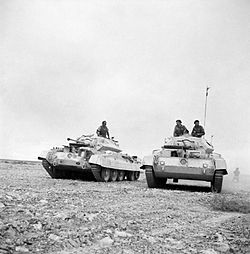This article is missing information about how many casualties were sustained by German forces during the battle.(April 2025) |
| Operation Scorpion / Unternehmen Skorpion | |||||||||
|---|---|---|---|---|---|---|---|---|---|
| Part of the Western Desert campaign of the Second World War | |||||||||
 The area of fighting from 24 March – 17 June 1941 | |||||||||
| |||||||||
| Belligerents | |||||||||
| | |||||||||
| Commanders and leaders | |||||||||
| William Gott | Maximilian von Herff | ||||||||
| Strength | |||||||||
| Infantry battalion and supporting arms | Kampfgruppe von Herff | ||||||||
| Casualties and losses | |||||||||
| 173 men 12 guns 5 Infantry tanks | |||||||||
Operation Skorpion (Unternehmen Skorpion) from 26 to 27 May 1941, was a military operation during the Western Desert Campaign of the Second World War. The operation was conducted by Axis forces under the command of Colonel Maximilian von Herff and British forces under Lieutenant-General William "Strafer" Gott. A counter-attack was made on British positions at Halfaya Pass in north-western Egypt, which had been captured during Operation Brevity (15–16 May).Unternehmen Skorpion was the second offensive operation commanded by Rommel in Africa (apart from the Siege of Tobruk).
Contents
- Background
- Unternehmen Sonnenblume
- Halfaya Pass
- Prelude
- Operation Brevity
- Plan
- Battle
- Aftermath
- Analysis
- Casualties
- Tiger Convoy
- Subsequent operations
- Axis defensive preparations
- Operation Battleaxe
- See also
- Notes
- Footnotes
- References
- Further reading
- External links
Skorpion pushed the British out of Halfaya Pass and forced them to retire to the area from Buq Buq to Sofafi. The Germans and Italians fortified the pass and built other strong points back towards Sidi Azeiz as tank killing zones, ready to meet another British attack. The British continued with preparations for Operation Battleaxe (15–17 June) but it was another costly British failure that led to the sacking of General Sir Archibald Wavell, Commander-in-Chief Middle East and other senior officers.


